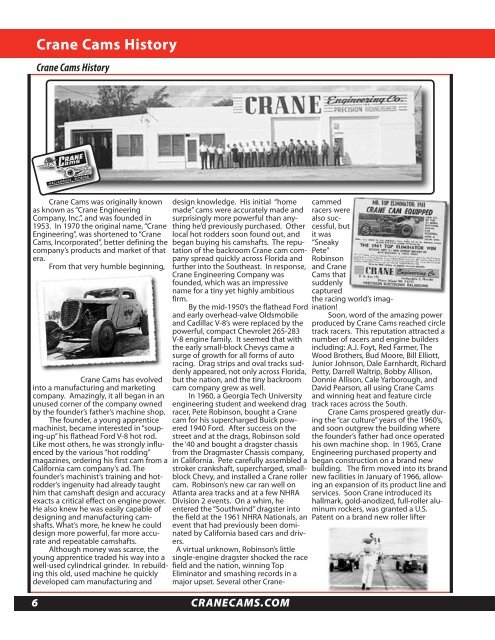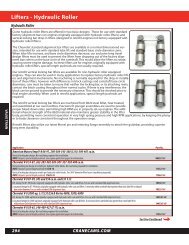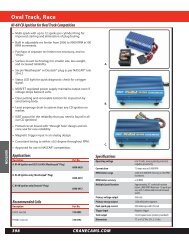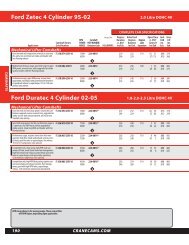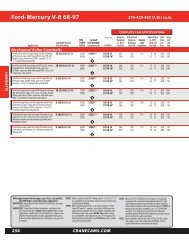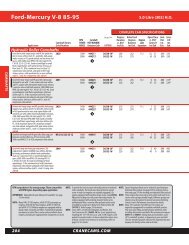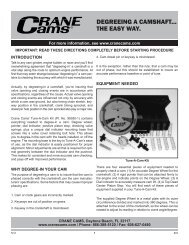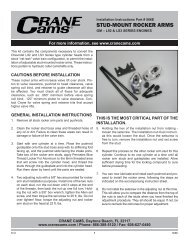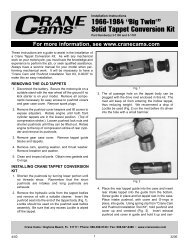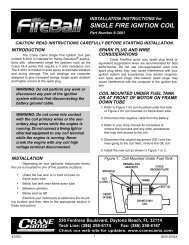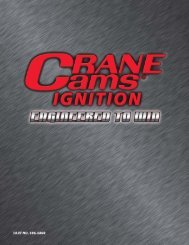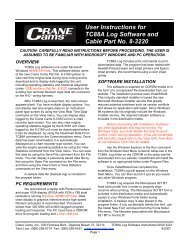2011 - Crane Cams
2011 - Crane Cams
2011 - Crane Cams
Create successful ePaper yourself
Turn your PDF publications into a flip-book with our unique Google optimized e-Paper software.
6<br />
<strong>Crane</strong> <strong>Cams</strong> History<br />
<strong>Crane</strong> <strong>Cams</strong> History<br />
<strong>Crane</strong> <strong>Cams</strong> was originally known<br />
as known as “<strong>Crane</strong> Engineering<br />
Company, Inc.”, and was founded in<br />
1953. In 1970 the original name, “<strong>Crane</strong><br />
Engineering”, was shortened to “<strong>Crane</strong><br />
<strong>Cams</strong>, Incorporated”, better defining the<br />
company’s products and market of that<br />
era.<br />
From that very humble beginning,<br />
<strong>Crane</strong> <strong>Cams</strong> has evolved<br />
into a manufacturing and marketing<br />
company. Amazingly, it all began in an<br />
unused corner of the company owned<br />
by the founder’s father’s machine shop.<br />
The founder, a young apprentice<br />
machinist, became interested in “souping-up”<br />
his flathead Ford V-8 hot rod.<br />
Like most others, he was strongly influenced<br />
by the various “hot rodding”<br />
magazines, ordering his first cam from a<br />
California cam company’s ad. The<br />
founder’s machinist’s training and hotrodder’s<br />
ingenuity had already taught<br />
him that camshaft design and accuracy<br />
exacts a critical effect on engine power.<br />
He also knew he was easily capable of<br />
designing and manufacturing camshafts.<br />
What’s more, he knew he could<br />
design more powerful, far more accurate<br />
and repeatable camshafts.<br />
Although money was scarce, the<br />
young apprentice traded his way into a<br />
well-used cylindrical grinder. In rebuilding<br />
this old, used machine he quickly<br />
developed cam manufacturing and<br />
design knowledge. His initial “home<br />
made” cams were accurately made and<br />
surprisingly more powerful than anything<br />
he’d previously purchased. Other<br />
local hot rodders soon found out, and<br />
began buying his camshafts. The reputation<br />
of the backroom <strong>Crane</strong> cam company<br />
spread quickly across Florida and<br />
further into the Southeast. In response,<br />
<strong>Crane</strong> Engineering Company was<br />
founded, which was an impressive<br />
name for a tiny yet highly ambitious<br />
firm.<br />
By the mid-1950’s the flathead Ford<br />
and early overhead-valve Oldsmobile<br />
and Cadillac V-8’s were replaced by the<br />
powerful, compact Chevrolet 265-283<br />
V-8 engine family. It seemed that with<br />
the early small-block Chevys came a<br />
surge of growth for all forms of auto<br />
racing. Drag strips and oval tracks suddenly<br />
appeared, not only across Florida,<br />
but the nation, and the tiny backroom<br />
cam company grew as well.<br />
In 1960, a Georgia Tech University<br />
engineering student and weekend drag<br />
racer, Pete Robinson, bought a <strong>Crane</strong><br />
cam for his supercharged Buick powered<br />
1940 Ford. After success on the<br />
street and at the drags, Robinson sold<br />
the ‘40 and bought a dragster chassis<br />
from the Dragmaster Chassis company,<br />
in California. Pete carefully assembled a<br />
stroker crankshaft, supercharged, smallblock<br />
Chevy, and installed a <strong>Crane</strong> roller<br />
cam. Robinson’s new car ran well on<br />
Atlanta area tracks and at a few NHRA<br />
Division 2 events. On a whim, he<br />
entered the “Southwind” dragster into<br />
the field at the 1961 NHRA Nationals, an<br />
event that had previously been dominated<br />
by California based cars and drivers.<br />
A virtual unknown, Robinson’s little<br />
single-engine dragster shocked the race<br />
field and the nation, winning Top<br />
Eliminator and smashing records in a<br />
major upset. Several other <strong>Crane</strong>-<br />
CRANECAMS.COM<br />
cammed<br />
racers were<br />
also successful,<br />
but<br />
it was<br />
“Sneaky<br />
Pete”<br />
Robinson<br />
and <strong>Crane</strong><br />
<strong>Cams</strong> that<br />
suddenly<br />
captured<br />
the racing world’s imagination!<br />
Soon, word of the amazing power<br />
produced by <strong>Crane</strong> <strong>Cams</strong> reached circle<br />
track racers. This reputation attracted a<br />
number of racers and engine builders<br />
including: A.J. Foyt, Red Farmer, The<br />
Wood Brothers, Bud Moore, Bill Elliott,<br />
Junior Johnson, Dale Earnhardt, Richard<br />
Petty, Darrell Waltrip, Bobby Allison,<br />
Donnie Allison, Cale Yarborough, and<br />
David Pearson, all using <strong>Crane</strong> <strong>Cams</strong><br />
and winning heat and feature circle<br />
track races across the South.<br />
<strong>Crane</strong> <strong>Cams</strong> prospered greatly during<br />
the “car culture” years of the 1960’s,<br />
and soon outgrew the building where<br />
the founder’s father had once operated<br />
his own machine shop. In 1965, <strong>Crane</strong><br />
Engineering purchased property and<br />
began construction on a brand new<br />
building. The firm moved into its brand<br />
new facilities in January of 1966, allowing<br />
an expansion of its product line and<br />
services. Soon <strong>Crane</strong> introduced its<br />
hallmark, gold-anodized, full-roller aluminum<br />
rockers, was granted a U.S.<br />
Patent on a brand new roller lifter


